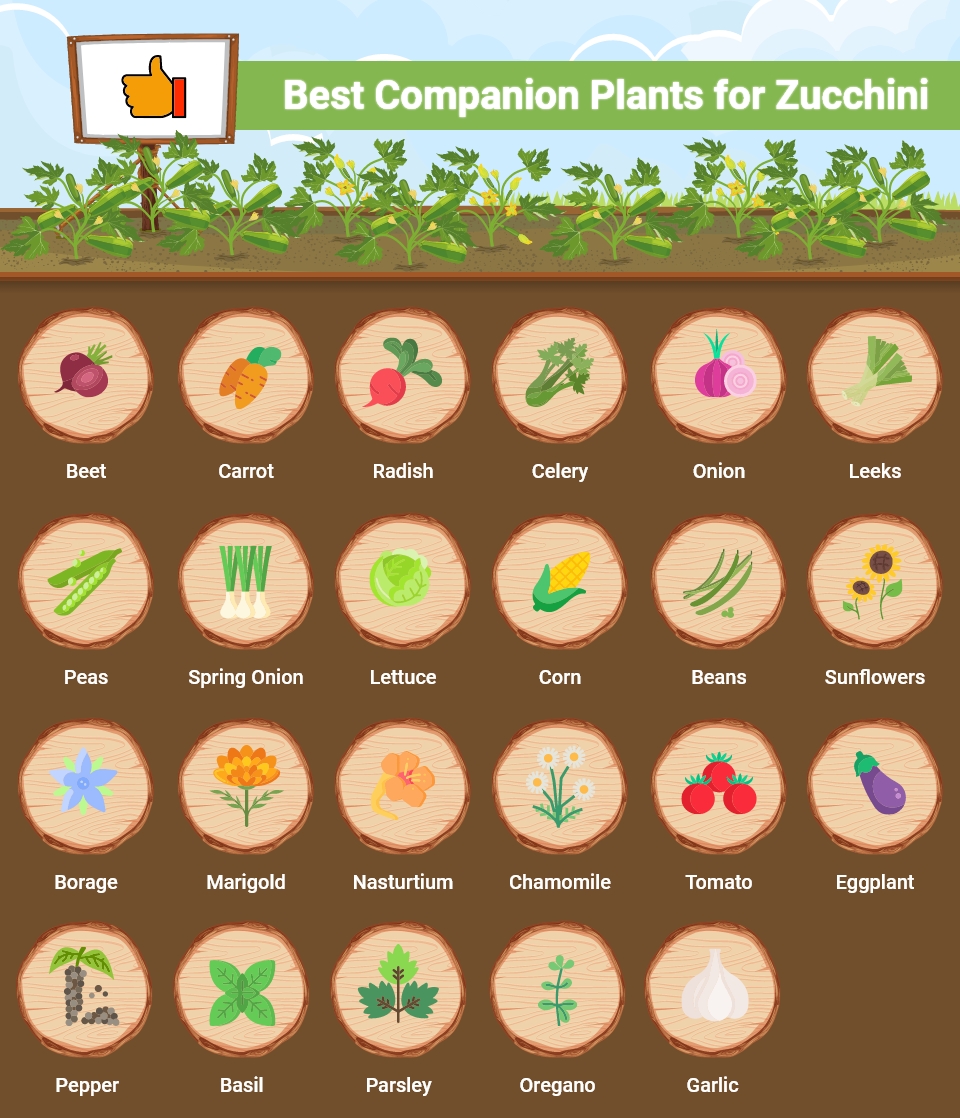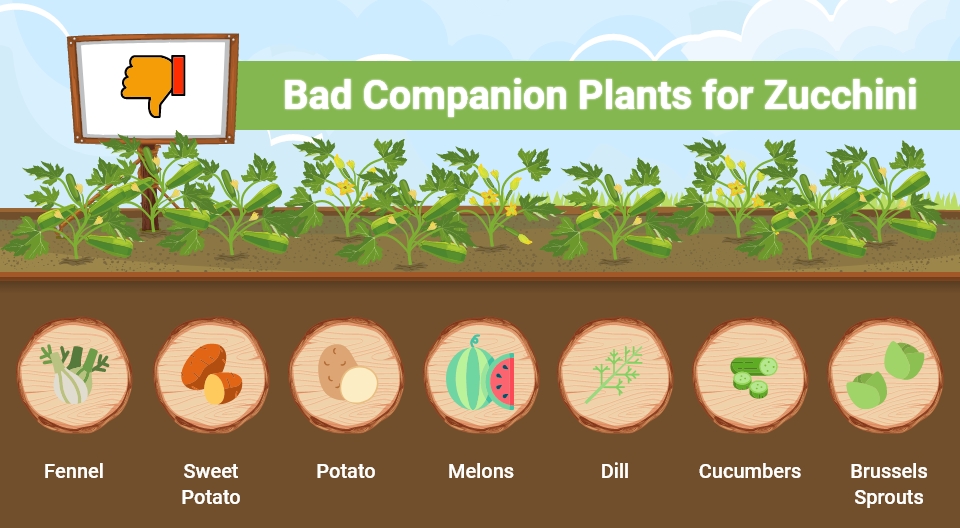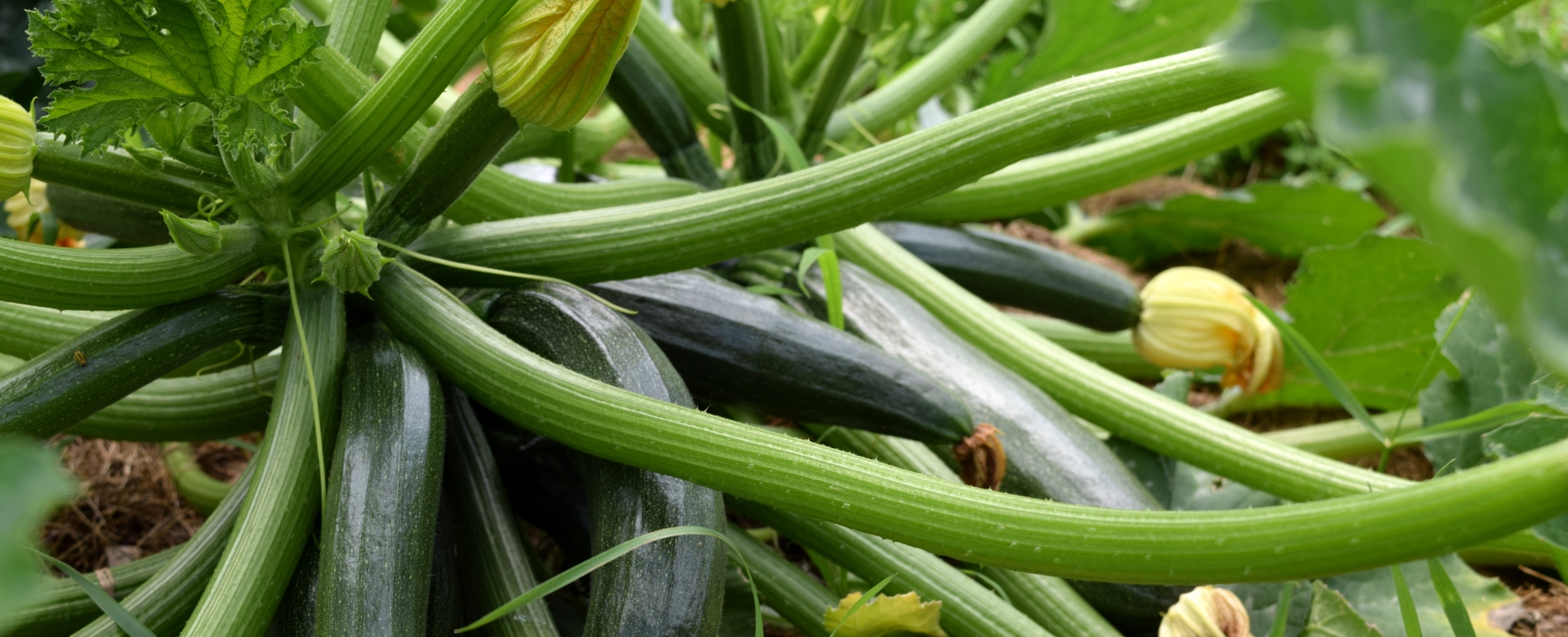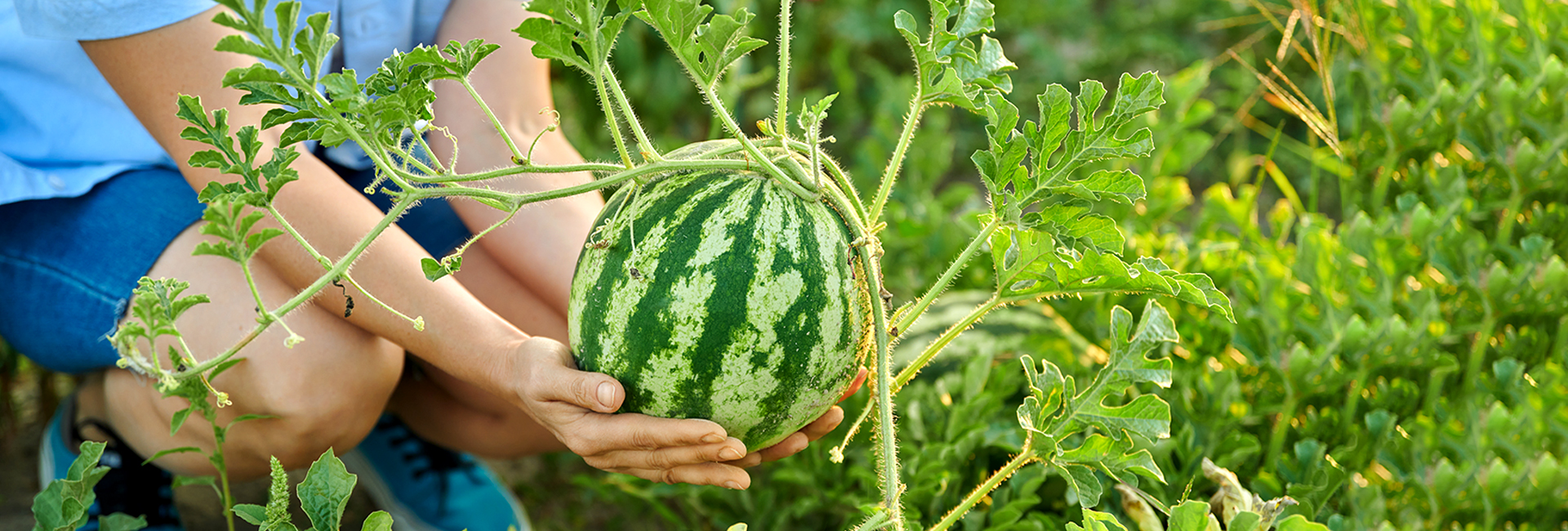Are you struggling with low yields from your zucchini patch, poor-quality produce, and pest issues? Well, you are not alone. Many gardeners face various issues like persistent pests, damaged crops, and wilting plants when growing zucchini.
So, how will you deal with such issues? Companion planting is an effective way to overcome these commonly faced gardening struggles. Strategically planting zucchini companion plants can improve the health and productivity of your zucchini patch and overcome several issues.
What are Zucchini Companion Plants?
Companion planting involves growing specific plants together with the main crop for various benefits. These benefits include keeping pests away, attracting pollinators, and promoting growth. Planting certain plants next to each other can create a more harmonious and productive garden environment.
How Companion Plants Can Benefit Your Zucchini Patch?
Companion plants in zucchini patch offer many benefits like improving plant health & productivity and managing pests. Below are some of their noteworthy benefits:
1. Pest Management
Natural Repellents: Companion plants like nasturtiums and marigolds release chemicals that repel pests like squash bugs, aphids, and nematodes. This reduces the need for chemical pesticides.
Trap Crops: Plants like radishes keep pests away from zucchini and act as a sacrificial crop to protect the main harvest.
Attracts Beneficial Insects: Herbs like oregano and flowers like borage attract pollinators and predatory insects (e.g., hoverflies and ladybugs) that feed on harmful pests.
2. Increased Yields
Attract pollinators: Flowers like borage and nasturtiums attract bees and other pollinators, which increases the chances of pollination and boosts zucchini yields.
3. Improved Soil Fertility
Fixing Nitrogen: Leguminous plants like peas and beans can fix the nitrogen in the soil and supply vital nutrients that zucchini plants require for healthy growth.
Nutrient Recycling: Deep-rooted plants like radishes can extract required nutrients from deep soil layers and make them available to shallow-rooted zucchini plants.
4. Suppress Weeds and Moisture Retention
Acts as Living Mulch: Leafy greens like lettuce and spinach act as ground cover. They reduce soil erosion and retain moisture, particularly in dry climates.
Suppresses Weeds: Dense planting of companion plants decreases the growth of weeds and blocks sunlight.
5. Microclimate Regulation
Shade Provision: Taller plants like corn shades zucchini plants to keep the soil cool and moist, especially during hot weather.
Wind Protection: Sturdy plants act as windbreaks, protecting zucchini plants against strong winds, which can cause stress and physical damage.
6. Disease Prevention
Diversified planting: A mix of different plants reduces the spread of diseases by creating a more resilient and diverse ecosystem, making it difficult for pathogens to establish and spread. Allelopathy: Some plants release certain chemicals that suppress specific pathogens’ growth or deter pest larvae. It helps grow healthy zucchini plants.
7. Improved Flavor and Growth
Flavor Improvement: When planted alongside zucchini, certain companion plants improve the flavor of zucchini when grown nearby.
Stimulates Growth: Some plants promote the growth and health of zucchini plants through their roots.
8. Improved Garden Vibrancy
Aesthetic Appeal: Companion plants like nasturtiums and marigolds bestow beauty and charm of your home garden, creating a vibrant space.
Diverse Ecosystem: Different companion plants create a varied and balanced garden, encouraging beneficial insects and creating a healthy environment for all your garden plants.
Best Companion Plants for Zucchini

- Lovage: It helps improve the vigor and flavor of most plants and offers a good habitat for ground beetles.
- Buckwheat: Attracts ground beetles and spiders and keeps them at bay from zucchini.
- Catnip: Helps deter squash bugs, flea beetles, Japanese beetles, and mice.
- Garlic & Onion: Repels aphids and other types of pests.
- Lemon Balm: Repels squash bugs, which makes it a good companion plant.
- Legumes: Legumes like peas help zucchini receive sufficient nutrients by fixing nitrogen and increasing the nutrient content in the soil.
- Spinach & Lettuce: Suppress weeds and acts as a living mulch.
- Radish: It is a trap crop for pests and protects zucchini against squash borers.
- Corn: Corn offers shade and prevents the squash vine borer beetle.
- Beans: Beans fix nitrogen and add essential nutrients to the soil. This improves the soil and benefits the plants growing beside them.
- Sunflower: As sunflower grows tall, it provides helpful shade for zucchini in hot areas.
- Borage: Borage attracts beneficial insects and deters pests from the zucchini plant. It enriches the soil and improves the growth and flavor of squash plants.
- Marigold: Marigold keeps beetles away from zucchini.
- Nasturtium: Nasturtium keeps whiteflies, cucumber beetles, squash bugs, wooly aphids, and other pests away.
- Chamomile: Chamomile attracts wasps & hoverflies and repels Mexican bean beetles.
- Marjoram: Marjoram is beneficial to almost all plants and has an important role in improving the growth and flavor of zucchini.
- Tansy: Tansy helps concentrate potassium in the soil and benefits neighboring plants. It repels squash bugs, cutworms, ants, flies, mosquitoes, striped cucumber beetles, Japanese beetles, cabbage worms, and fruit moths.
- Oregano: Oregano protects against pests. Further, it attracts beneficial insects like hoverflies and syrphid and repels aphids.
Bad Companion Plants for Zucchini

- Fennel: Avoid planting fennel near zucchini, as it can stunt the growth of several plants, including zucchini. The plant produces a chemical through the roots that inhibits zucchini’s growth. Besides, it attracts harmful insects like spider mites and aphids.
- Potatoes: Potatoes are heavy feeders, which require several nutrients from the soil to grow. When planted near zucchini, potatoes can compete for essential nutrients, leading to stunted growth for both plants. Besides, both potatoes and zucchini are susceptible to the same disease – blight, which can spread from one plant to another.
- Melons: Melons and zucchini are susceptible to the same pests—cucumber beetles, which can cause the spread of bacterial wilt and squash mosaic virus. It can impact plants’ health and yield. Both are heavy feeders and can compete for nutrients. It is best to plant them at a certain distance from zucchini so that both can get the essential nutrients they require.
- Brussels Sprouts: Brussels sprouts require cool temperatures to thrive and have a long growing season, whereas zucchini requires warm temperature. Also, Brussels sprouts are susceptible to pests like cabbage moths, cabbage worms, and aphids, which might attack zucchini plants.
Zucchini Companion Planting Tips for Success

Companion plants improve the health and productivity of your zucchini patch. Let us know in detail about the planting instructions, spacing and mature size of zucchini and its companion plants.
Planting instructions for zucchini and companions
Zucchini: Direct zucchini seeds after the last frost date when the soil temperature is consistently above 60°F. You can also start seeds indoors about 2-4 weeks before the last frost and transplant seedlings.
Sow seeds about 1 inch deep in the soil. Zucchini plants should be spaced about 2-3 feet apart in rows to accommodate sprawling growth.
Companion Plants:
Beans and Peas
Plant peas seed early in the growing season as soon as the soil can be worked. Beans can be planted after the soil warms up. Sow seeds about 1 inch deep in the ground.
Marigolds and Nasturtiums
Sow seeds directly once the last frost date has passed or start seeds indoors 6-8 weeks before planting them.
Herbs (Oregano and Dill)
Sow seeds directly in the garden after the last frost date or you can choose to start seeds indoors and transplant.
Corn
Plant corn once the soil gets warm to 60°F, ideally a few weeks after the last frost date. Sow seeds about 1 inch deep.
Plant Spacing and Mature Size of Zucchini and Companion Plants
Each zucchini plant can spread its growth about 3-4 feet wide. Ensure there is ample space for air circulation and sunlight.
Companion Plants
Beans and Peas:
They can climb and grow upwards. They require less space on the ground, therefore provide vertical support. Space them about 2-4 inches apart.
Marigolds and Nasturtiums:
These flowers stay low and spread out, which helps with ground space and proves useful in controlling pests. Space these flowers about 8-12 inches apart to maximize their pest-repelling benefits.
Herbs (Dill and Oregano):
Herbs grow compact, but you should space them to avoid overcrowding. Space them about 12 inches apart.
Corn:
Corn grows tall, so plant them on the northern side to avoid shading your Zucchini plant too much. Corn plants should be spaced about 12-18 inches apart in rows about 3-4 feet apart.
Garden Layout Tips for Zucchini and Companion Plants
Set Zones
Group plants with similar growing requirements together. For instance, plant all herbs in one section and flowers in another.
Perimeter Planting
Use nasturtiums and marigolds around the border of the zucchini patch to get protection against pests.
Vertical Space
Use vertical space by planting climbing plants like peas and beans on trellises. This frees up ground space for zucchini plants.
Row Orientation
You should align rows North to South to ensure even sunlight gets distributed across all plants.
Seasonal Considerations
Fall
You should harvest zucchini before the frost date. Ensure you clean off all the garden debris to prevent overwatering of pests and diseases.
Spring
Consider planting zucchini and its companion plants once the last frost is over. While you consider planting, ensure soil temperature is ideal for germination process.
Summer
It is essential to monitor pests regularly for pests and diseases. Water consistently and mulch to retain moisture and regulate soil temperature.
Soil Preparation
- Firstly, you should check soil pH and nutrient levels. Zucchini plants prefer slightly acidic to neutral soil with pH of 6.0-7.5.
- Include compost or well-rotted manure to improve soil fertility and structure. Use balanced organic fertilizers if required.
- Till the soil lightly to a depth of 8-12 inches to aerate and incorporate organic matter.
- Apply a layer of mulch around Zucchini plants and companion plants to conserve moisture, suppress weeds, and to regulate soil temperature.
Common Mistakes to Avoid with Companion Planting

You should avoid the below mistakes while growing companion plants with zucchini:
- Improper sowing of seeds
- Starting the planting process too early
- Neglecting sunlight requirements
- Inadequate watering
- Improper watering
- Overlooking soil quality
- Not adding extra fertilizers
- Lack of pollination
- Harvesting too late
- Feeding bugs
- Ignoring pest and disease issues
- Growing incompatible plants
- Not mulching
- Not providing enough space
- Not removing weeds
How can these mistakes be detrimental?
Incompatible Companion Plants
Avoid planting incompatible companion plants with zucchini as it can negatively affect each other’s growth. (For instance, tomato and potato)
Impact: Growing incompatible companion plants with zucchini causes companion plants to compete for water, nutrients, and light with the main crop. Some companion plants even release harmful chemicals that can inhibit the growth of neighboring plants.
Solution: Conduct in-depth research about companion plants that can be grown alongside the Zucchini plant.
Overcrowding Plants
Avoid planting compatible plants that are too close together.
Impact: Don’t overcrowd zucchini plants, as this might result in plants competing for resources. Further, it might lead to poor circulation, leading to disease susceptibility.
Solution: Follow recommended space guidelines for each plant. For instance, provide enough space for carrots and tomatoes so they don’t compete for essential nutrients with the main crop.
Ignoring Sunlight Needs
Avoid pairing companion plants that require different amounts of sunlight for their growth. For instance, don’t grow shade-tolerant plants with sun-loving companion plants.
Impact: Companion plants that don’t receive adequate sunlight become stressed. Stressed plants are prone to pests and disease.
Solution: Group companion plants that have similar sunlight requirements together. For instance, you can grow corn and beans with cucumbers, which can also thrive well in full sun.
Overlooking Soil Quality
companion plants with different nutrient and soil pH requirements. (e.g., tomatoes and blueberries)
Impact: Overlooking soil quality causes only one plant to thrive successfully, while the other companion plants need help in better soil quality conditions.
Solution: Group plants with similar soil preferences and requirements. For example, carrots and beans prefer slightly acidic to neutral soil.
Failing to Consider Pest & Disease Problems
Growing companion plants susceptible to the same pests and diseases. For example, tomatoes and eggplants.
Impact: Pests and diseases can multiply and spread rapidly between susceptible plants, causing significant damage to the main crop.
Solution: To deal with pest and disease issues, consider crop rotation and trap cropping—for instance, plant marigolds with tomatoes.
Avoiding Competing Growth Habits
Growing tall and sprawling plants together. For example, pumpkins and corn.
Impact: Tall companion plants can overshadow short plants, restricting access to air and sunlight.
Solution: Pair tall, sun-loving plants with low-growing, shade-tolerant ones. Plant corn with beans and squash. Beans will use corn stalks as support, and squash will shade the ground to minimize weeds.
Lack of Pollinators
Failing to grow companion plants that attract pollinators.
Impact: Lack of pollinators leads to poor fruit set and decreased yields.
Solution: Try growing flowering plants like borage or nasturtiums, which help attract pollinators and other beneficial insects.
Conclusion
Companion planting offers several benefits which include pest control, improved soil health, plant growth, yield, space efficiency, disease prevention, environmental sustainability, and practical gardening benefits. By leveraging the strengths of different plants, gardeners can create healthy, productive, and beautiful gardens.




